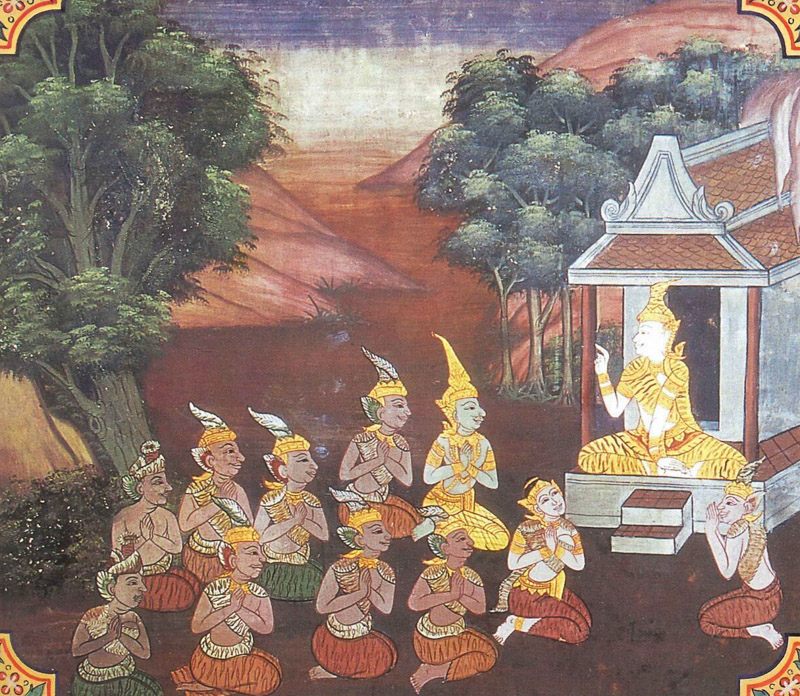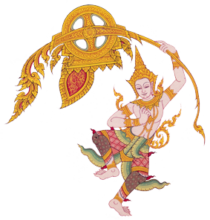
The Bodhisatta was once an ascetic. He was born into a wealthy family, but was uninterested in worldly things and would not let his parents fix him up with a wife. When his parents died, he gave away the family fortune and became an ascetic, as did his six younger brothers and one sister. They went to the Himalayas, taking a friend, a male slave, and a maid with them, and lived a holy life near a lotus lake, eating the fruits and roots of the forest.
They took turns collecting food (though the Bodhisatta, his sister, and the maid were exempt from this duty), and whoever gathered it in the morning laid out eleven portions and banged a gong to signal the food was ready to be picked up.
The family’s perfect virtue caused the throne of Indra, king of the gods, to shake. When Indra divined the cause, he ran a test to determine whether they were just free of desire or if they were proper sages. For three days in a row, Indra caused the Bodhisatta’s share of food to disappear. On the first day, the Bodhisatta assumed it had been a mistake. On the second day, he figured someone was subtly informing him of some fault in his behavior, and on the third day, he sounded the gong and summoned the others to a meeting. The three brothers who had gathered food over the last three days denied withholding his share, so the Bodhisatta figured it must have been stolen. Everyone felt agitated by the possibility. At this point, three other beings who lived near them—the forest’s chief tree fairy, an elephant who had escaped from his owner to live free in the forest, and a monkey who used to perform in a snake charmer show—joined the meeting. All thirteen of them swore an oath that they had not taken the food and invited curses to befall the guilty. They hoped the thief would have great treasures, a big family, sweet food to eat, a heart full of desire and pride, and faith in the stars and lucky days—all things that would ruin an ascetic’s life.
Indra, who had been watching the proceedings, revealed himself and asked the Bodhisatta why they all disdained the things that bring most humans such joy. He answered that desires were chains that bound men, leading to sin and misery. Indra was pleased by this answer and confessed his experiment. The Bodhisatta rebuked Indra for making sport of them, but accepted his apology. Indra saluted them all and returned home to heaven. And for the rest of their lives the band of ascetics never wavered from their righteous path.
In the Lifetime of the Buddha
A man of noble birth gave up his easy life to become a disciple of the Buddha and was completely dedicated to dharma. One day during an alms round he met a beautiful woman and fell in love at first sight. Overcome by passion, he became so depressed that he stopped cutting his hair and nails and cleaning his robes, became thin and weak with yellow skin and veins sticking out of his body, and no longer took joy in his life of solitude.
When the Buddha found out about his problem, he told this disciple that the woman was wicked and he should get her out of his mind. Then the Buddha told the disciple this story to explain how in the past he himself had not wavered from the righteous path when he was an ascetic. Hearing this, the disciple overcame his lust and regained his health.
The Bodhisatta’s brothers were earlier births of Sariputta, Moggallana, Punna, Maha Kassapa, Anuruddha, and Ananda, six of the Buddha’s top disciples. His sister and maid were earlier births of Uppalavanna and Khujjuttara, one of the Buddha’s top female disciples and top lay followers respectively. The tree fairy was an earlier birth of Satagira, a goblin who supported the Buddha and worked hard to spread his message; the slave was Citta, one of the Buddha’s most devoted lay followers; the elephant was Parileyya, an elephant who cared for the Buddha during a time he stayed alone in a forest; the monkey was Madhuvasettha, a prominent brahmin from the Buddha’s time; and Indra was Kaludayi, another of the Buddha’s top disciples.
